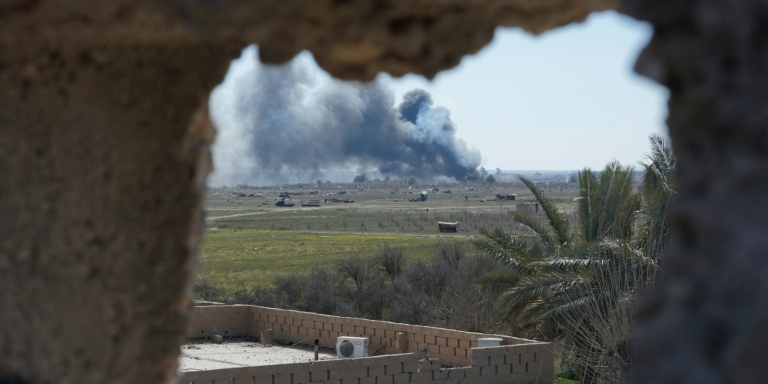INTELBRIEF
March 8, 2019
IntelBrief: Reports of the Islamic State’s Demise Are Premature

- Within days, coalition forces expect to retake the Syrian village of Baghouz, the final sliver of territory held by the so-called Islamic State.
- As difficult as the military phase of the conflict has been, the next stage presents a host of challenges, including what to do with female members of the group, as well as children.
- The Islamic State has already shifted to a more clandestine entity that manifests itself in periodic but persistent attacks, including assassinations.
- The Islamic State will inevitably rise again and attempt to retake the territory that once formed its erstwhile state-building project in Iraq and Syria.
.
The military fight against the Islamic State has been exceedingly difficult and costly, especially to the Iraqi and Syrian forces that have fought the group for years, but also to civilians uprooted from their homes and forced to flee in order to survive. As the stage of ‘reclaiming’ the physical territory from the Islamic State is nearing an end, at least in Syria, the Syrian Democratic Forces (SDF) expect to retake the remaining few acres of land around Baghouz imminently. The scenes emerging from Baghouz have been sobering, with the final holdouts of a once powerful terrorist group being rounded up and interrogated, while female members of the group, as well as children, are examined for serious injuries. Some of the women have remained particularly defiant, openly cursing their captors as ‘infidels’ while expressing few regrets for their role in sustaining the caliphate. Each day, more bodies are unearthed from shallow graves pockmarking the area.
The battle to hold that reclaimed territory is just beginning, and the anti-Islamic State forces are already losing ground. There is justifiable concern that the U.S. and others will pull back prematurely, curbing the effort and funds necessary to finish the fight in a more permanent sense. The view that the Islamic State can be lastingly diminished while the underlying conditions that fueled its rise remain unchanged is short-sighted and dangerous—it is also naïve and ignorant of recent history, including the rise of IS from the ashes of its predecessor, al-Qaeda in Iraq. The Islamic State is many things at once: it is a physical group that once held territory the size of Great Britain in the heart of the Middle East (it still retains several dangerous franchise groups outside of the region); it is an ideology and a brand that inspires its followers to kill in its name; and it is also a latency, something that exists while hidden just below the surface, not fully manifesting in the conditions of daily life in parts of Iraq and Syria.
The forces that oppose the Islamic State and other groups of its ilk are focused on fighting the armed threat and to a lesser extent, attempting to counter the violent ideology the motivates its supporters. The scale of the challenge to bring positive and sustainable change to the parts of Iraq and Syria where the Islamic State once held power dwarfs the immense effort to diminish the group militarily. The Islamic State has already shifted to a more clandestine entity that manifests itself in periodic but persistent attacks and generates an overwhelming dread in the populace that the group is still there, just waiting. There are already reports of jihadist checkpoints and a surge in assassinations attributed to the militants, who, already intimately familiar with the terrain, move with relative ease at nighttime. The destruction of the places reclaimed from the group during the conflict is impossible to overstate. Amidst the rubble and the deprivation, reconstruction and recovery are mere buzzwords used by well-meaning bureaucrats and development specialists. The daily miseries of post-conflict Iraq and Syria is where the Islamic State will find its re-nourishment.
Cities, towns and villages, including large swaths of the Middle Euphrates River Valley and its surrounding environs, are in ruin both physically and socially. Most of the media focus has highlighted the plight of foreign fighters and the policy issues faced by their home countries, while too little attention has been paid to displaced Syrians and Iraqis who will populate refugee camps, living in squalid conditions. There is no local government capable of addressing even a modicum of the population’s needs, nor will there be anything resembling good governance or the rule of law well into the foreseeable future—in one sense, the absence of these indicators is what helped give rise to IS in the first place. The scale of aid, and perhaps more importantly, the timeline in which that aid must be sustained, is the real test of the meaning of ‘Inherent Resolve,' the U.S. military’s name for its campaign against the Islamic State in Iraq and Syria. Even with a well-designed and robustly-funded reconstruction campaign, the latent Islamic State will inevitably reformulate, returning to terrorize civilian populations and laying claim to the territory that once formed its erstwhile state-building project.
.
For tailored research and analysis, please contact: info@thesoufancenter.org
[video width="960" height="540" mp4="https://thesoufancenter.org/wp-content/uploads/2019/03/IB-0308.mp4" poster="https://thesoufancenter.org/wp-content/uploads/2019/03/Screen-Shot-2019-03-08-at-01.34.41-1-e1551999799367.png"][/video]